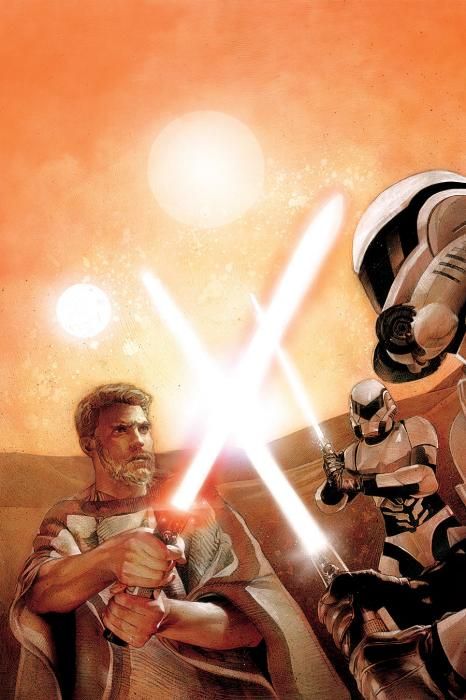"The Star Wars" #3 by J.W. Rinzler and Mike Mayhew continues the adaptation of George Lucas' original rough draft for what eventually became "Star Wars," and in this issue takes readers through parts of the script that survived relatively intact from the draft stage to final execution. Consequently, this part of the story feels a little more familiar than that told in prior issues, albeit still with a noticeably different air that's almost nostalgia-invoking, but not quite. Yes, that's See Threepio and Artwo Detwo in the space pod that lands on a desolate desert planet, and yes, that's how their names are spelled, but no; they aren't quite "our" C-3PO and R2-D2.
At least, not yet; it's intriguing and disquieting at the same time to see "Artwo" speak fluently instead of chirping and whistling, and even exhibiting some of the personality traits that were eventually given instead to Threepio. It's intriguing because this is a fleshed-out and finished version of ideas first conceived nearly forty years ago but rarely seen, and disquieting because, well, it's a fleshed-out and finished version of something that had yet to be fleshed out and finished. While it's fun to see Lucas' early ideas put onto a canvas where they can be polished and displayed, rather than as mere concept sketches and margin notes, these were ideas that weren't ready for such treatment at this point in their development; it's called a "rough" draft for a reason. There was still more thought to be put forth, more evolution to occur, and details to be worked out. This series is a straight-line extrapolation from a concept at one point in time to a finished product, and because of this falls short because it lacks the growth and fine-tuning that was done long before the idea was made into a film. It's interesting, to be sure, but it's the equivalent of putting frosting on the cake before it was even finished baking; consumable, sure, but not near what it could and should have been.
Rinzler does the best he can with the ingredients he's been given, but he's been asked to serve up something now that really needed to age first. There are references to elements from the newer prequels, in fact, but it's unclear whether these actually existed in Lucas' early draft or if Rinzler included them on his own. The comic works best if it's not looked at as a story, but rather an exhibit; one that's almost like looking into a parallel world where Luke Skywalker's Jedi pal Kane Starkiller has two sons named Annikin and Deak. It's fun to imagine, but easy to be thankful that things turned out differently.
Mayhew makes this exhibit attractive, although with way too much inconsistency. His character close-ups are exquisitely detailed, with almost photo-like realism with the help of colorist Rain Beredo, but when he pans back his grasp of faces drastically weakens, his characters become stiff, and there's little flow during the action sequences. There are some impressive looking panels with some great renderings of early incarnations of the ships and tech of the Star Wars universe, as it existed then, but like the writing, the art works better as a collection of images that showcase this still-developing world, rather than facilitating the telling of a story.
As part of a continuing story, "The Star Wars" #3 doesn't really work by the inherent virtue of its work-in-progress nature. But as a showcase that unearths these old ideas from the mind of George Lucas and makes them presentable for display, it's far more successful. It's an odd mixture that falls just on the good side of being fun.

